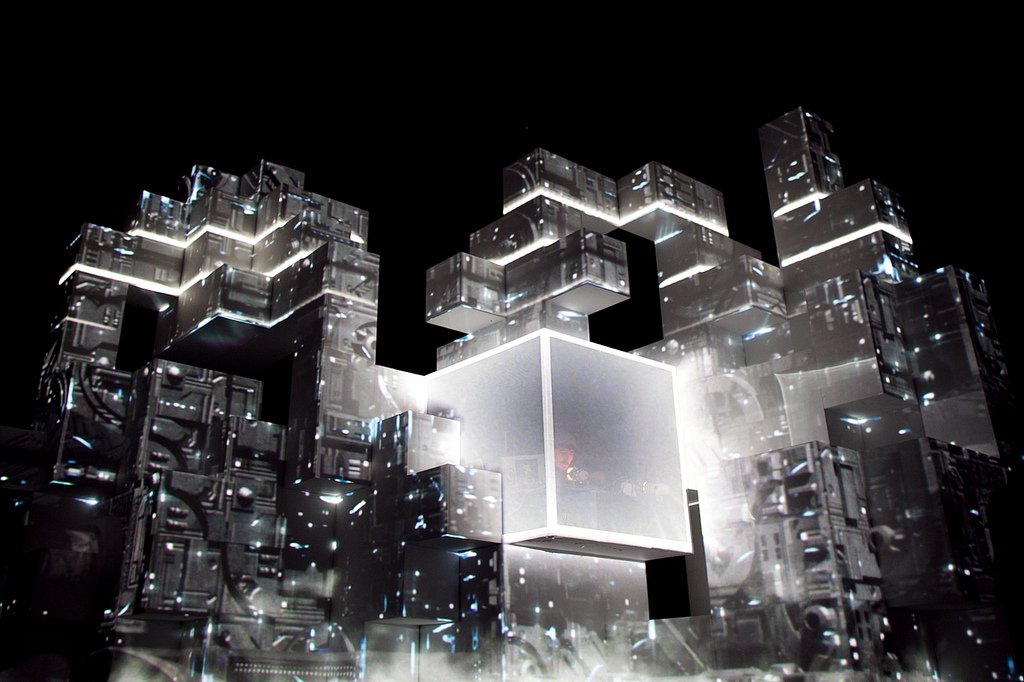
Founded in 2003, Decibel became a unique platform for exposing attendees to leading-edge multimedia art from around the globe. With a focus on live performance, interactive multimedia art, state-of-the-art sound and technology based education; Decibel solidified itself as one of the premier electronic music festivals and promotional organizations in the world. The five-day festival program averaged over 25,000 attendees a year. Outside of the annual festival program, Decibel Presents has produced hundreds of one-off events, ranging from intimate club performances to massive international festival stages.
In 2015 Decibel celebrated its final festival program in the Seattle area. Since then Decibel has been functioning as a Los Angeles-based event/production company.
Over the years Decibel has hosted hundreds of events, featuring over 1,100 unique performers from over 40 countries, including; Amon Tobin ISAM LIVE (US debut), ODESZA, Lorde (Northwest debut), Justice (West Coast debut), Erykah Badu & The Cannabinoids (Northwest debut), James Blake (West Coast debut), Charli XCX (West Coast debut), Kaytranada, Nils Frahm, Deadmau5 (Northwest debut), Richie Hawtin, Flume (Northwest debut), Zedd, Flying Lotus, Four Tet, Tycho (World debut), Dixon (West Coast debut), Duke Dumont (Northwest debut), Boys Noize (West Coast debut), Diplo, The Blessed Madonna (Northwest debut), Moby, Toro y Mio, Nina Kraviz (Northwest debut), Bonobo, Autechre, Volker Bertelmann aka Hauschka (West Coast debut), Empire of the Sun (Seattle debut), Moderat (US debut), Tale Of Us (Northwest debut), Ben Klock (Northwest debut), RL Grime (Northwest debut), Nicolas Jaar (Northwest debut), Jóhann Jóhannsson (West Coast debu), Claude VonStroke (Northwest debut), Icona Pop (Northwest debut), Orbital, Olafur Arnalds (West Coast debut), Oneohtrix Point Never (Northwest debut), Unknown Mortal Orchestra, Green Velvet, Modeselektor (North American debut), Trentemoller (West Coast debut), DARKSIDE (Northwest debut), Jon Hopkins (Northwest debut), Dubfire (Northwest debut), Daniel Avery (Northwest debut), Simian Mobile Disco (Northwest debut), Maya Jane Coles (Northwest debut), KiNK (West Coast debut), Seth Troxler, Max Cooper presents Emergence (World debut), Tiga (Northwest debut), Chris Liebing (Northwest debut), Harold Budd, Stars of the Lid (West Coast debut), TOKiMONSTA (Northwest debut), Hot Since 82 (Northwest debut), Glitch Mob, SOHN, John Talabot (West Coast debut), Gui Boratto (West Coast debut), The Orb, Booka Shade (Seattle debut), Shlohmo (Northwest debut), Ladytron, DJ Shadow, Tensnake (Seattle debut), Marcell Dettmann (Northwest debut), Pete Tong, Apparat (US debut), Justin Martin (Northwest debut), Carl Craig, Fennesz feat. Lillevan (North American debut), Skream, Derrick May, Pantha Du Prince (West Coast debut), DJ Krush, Talaboman (World debut), Scuba (West Coast debut), Kimbra, Zola Jesus feat. JG Thirlwell (West Coast debut), Dusky (Northwest debut), Ben Frost (West Coast debut), The Nortec Collective, Speedy J feat. Scott Pagano (North American debut), Dan Deacon, Gold Panda, Benga, Henrik Schwarz (Northwest debut), Jackmaster (Northwest debut), Recondite (West Coast debut), Andy Stott (Northwest debut), Arca feat. Jesse Kanda (Seattle debut), DVS1 (Seattle debut), Ben UFO (Northwest debut), Wolf + Lamb (West Coast debut), Mad Professor, Theo Parrish, dOP (Northwest debut), Monolake (West Coast debut), Rival Consoles (Northwest debut), Matthew Dear (West Coast debut), Ariel Pink, Zomby (North American debut), Mount Kimbie (West Coast debut), AtomTM (West Coast debut), Robin Guthrie, Steffi (Northwest debut), Joy Orbison (Northwest debut), Axel Boman (Northwest debut), Kode9 (West Coast debut), Cobblestone Jazz, Murcof, The Field (West Coast debut), Shpongle, Derrick Carter, Tiger and Woods (West Coast debut), Com Truise (Northwest debut), Tim Hecker, !!!, Clark, Shackleton (West Coast debut), Move D (West Coast debut), Tipper, Objekt (North American debut), Robert Henke (US debut), Lindstrom, Pezzner (World debut), Claptone (Northwest debut), MK (Northwest debut), The Sight Below (World debut), John Tejada, Kim Ann Foxman, Sango (Seattle debut), 1979 feat. Deru + Effixx (World debut), Deadbeat (West Coast debut), Son Lux, T.Williams (Northwest debut) and hundreds more.
Decibel Festival Partners and Sponsors include, Red Bull Music Academy, Windows, Verizon, Pabst, Tito’s, Stolichnaya, Bacardi, Dewar’s, Sierra Nevada, Pyramid Ales, Dunhill, Clif Bar, Kind Snacks, Kleen Kanteen, Best Western Hotels, W Hotel, EMP Museum, Yelp, Uber, Roland, Rane, Ableton, Mackie, Native Instruments, Propellerheads, Teenage Engineering, AIAIAI Headphones, EAW, Resident Advisor, Mixmag, Beatport, URB Magazine, KEXP 90.3, The Stranger, Warp Records, Erased Tapes, Ghostly International, Sub Pop, Mad Decent, Kompakt, Hyperdub, McCauley Sound, MUTEK, Dama, The Seattle Mayor’s Office of Film and Music, Stumptown Coffee, Easy Street Records, Movement Festival, MUTEK Festival, Dimensions Festival, The Seattle Art Museum, The Vera Project, Chihuly Garden & Glass, Modern Love, Substantial, Visit Seattle and dozens more.
